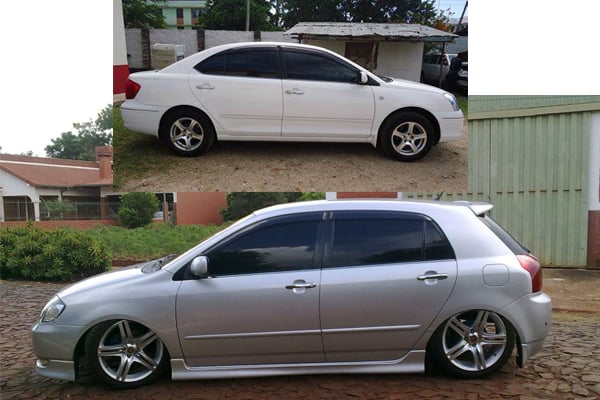Prime
Head to Head: 2003 Toyota Premio vs 2003 Toyota Allex

Wood trim and silver accents gives the Premio (above) an elegant look. The Allex’s compact design (below) is popular among the youth.
What you need to know:
- The Premio and Allex share some DNA in the form of similar engines, suspension design as well as interior amenities. However, their concepts, performance and market appeal are different so they are not easily comparable as apples for apples.
The 2003 Toyota Premio is a sports sedan built on the Corona platform while the 2003 Toyota Allex is a sports compact hatchback built on the slightly smaller Corolla platform. Both Premio and Allex come with a five seat configuration.
Performance and fuel economy
In Uganda, the most popular Toyota engines in the Premio and Allex are the petrol 1.5 Litre 1NZ-FE and the petrol 1.8L 1ZZ-FE. They share engine performance with slightly different fuel economy statistics because of different overall size and design. The 1.5 L petrol engine’s power output is a modest 109 horsepower for both Premio and Allex. However, it delivers an impressive fuel economy of 18.0 km/ litre for Premio a slightly better 18.2 km/ litre for the smaller Allex.
The 1.8 L petrol engines in the Premio and Allex deliver 120 horsepower and good fuel economy of 16 km/ litre for the Premio and 16.6 km/ litre for the Allex. Premio offers a 2.0 litre petrol engine, which is attractive for the ‘heavier footed’ motorist.
Handling
The Premio and Allex have modest road manners and reasonable body control thanks to their front independent suspension with Mcpherson struts and coils while the rear axle control blade multi links, coil springs and dampers. Premio’s wider wheel base (270cm vs 260cm) gives it a more settled on road experience with a firmer, more responsive steering compared to the narrower and shorter Allex. Both cars can comfortably traverse our suburban roads courtesy of their impressive 160mm ground clearance.
Comfort, style and safety
The Premio looks more stylish and sleek. Its longer profile, more prominent headlights and tail lights make it suitable for young corporates and families. The Allex plays second fiddle, and looks like a city hopper suitable for the ‘penny wise.’ The Premio’s seats are more supportive and comfortable.
Compared to Allex, Premio is roomier and although it offers walnut burl wood impression, its interior still feels plasticky and egalitarian.
Both cars offer basic trappings CD music, air conditioning, electric windows and mirrors. Premio’s boot space is slightly bigger but rear passenger space is a little cramped up. Allex has a smaller seating room and luggage space. Both Premio and Allex have passive driver aids to enhance safety such as Anti-lock brakes (ABS) and front dual airbags.
Reliability, resale value
Both cars ride on the easier access to quality new and used Toyota spare parts. The engine technology in both cars requires diligent routine maintenance with high grade lubricants and genuine parts.
The Premio will have a better resale value because it is big enough for young corporates and families, yet pocket-friendly to own and maintain. Both the Premio and Allex window switches and side mirror glasses are a target for petty thieves and house burglars, but that is not a show stopper.
Verdict
The two cars are equally attractive buys with different appeals. The Premio has better handling, practical styling and comfort. However the Allex’s compact design is a popular among the youth and city run-about drivers. Both cars share engines with slightly varying performance and fuel economy statistics because of shape and design. Nevertheless, they both offer reasonably safety and their spare parts are readily available parts and both have good resale value.




